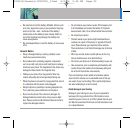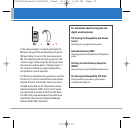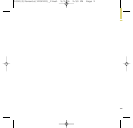
Migo 29
in all tested frequency bands. Although SAR is deter-
mined at the highest certified power level, the actual
SAR level of the phone while operating can be well
below the maximum value. Because the phone is
designed to operate at multiple power levels to use
only the power required to reach the network, in gen-
eral, the closer you are to a wireless base station
antenna, the lower the power output.
Before a phone model is available for sale to the pub-
lic, it must be tested and certified to the FCC that it
does not exceed the limit established by the govern-
ment-adopted requirement for safe exposure. The
tests are performed in positions and locations (e.g., at
the ear and worn on the body) as required by the FCC
for each model.
The highest SAR value for this model phone when
tested for use at the ear is 1.24 W/kg and when worn
on the body, as described in this user guide, is 0.839
W/kg (body-worn measurements differ among phone
models, depending upon available accessories and
FCC requirements). While there may be differences
between SAR levels of various phones and at various
positions, they all meet the government requirement
for safe exposure.
The FCC has granted an Equipment Authorization for
this model phone with all reported SAR levels evaluat-
ed as in compliance with the FCC RF emission guide-
lines. SAR information on this model phone is on file
with the FCC and can be found under the Display
Grant section of http://www.fcc.gov/oet/fccid after
searching on FCC ID BEJVX1000.
Additional information on Specific Absorption Rates
(SAR) can be found on the Cellular
Telecommunications Industry Association (CTIA)
website at http://www.wow-com.com.
* In the United States and Canada, the SAR limit for
mobile phones used by the public is 1.6 watts/kg
(W/kg) averaged over one gram of tissue. The
standard incorporates a substantial margin of
safety to give additional protection for the public
and to account for any variations in measure-
ments.
1000(E)Parents(120X120)_final 5/2/06 2:49 PM Page 29


















